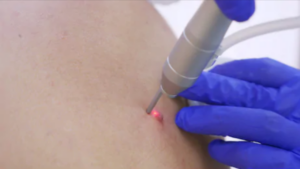
Just what exactly is the connection between melanoma being found where a mole was removed with a laser?
Many people opt to have a mole “vaporized” by laser rather than their skin cut and broken into (which then causes scar formation).
For those who are concerned about scars and infection, laser mole removal offers advantages to surgical excision.
The kind of mole that’s most appropriate for removal via laser is a raised lesion.
A doctor should examine the mole to be removed for any signs of melanoma such as crusting, odd asymmetry or jagged borders.
A subjective report from the patient, such as, “It’s gotten a lot bigger and darker over the past several months,” will also be taken into consideration.
If the physician suspects melanoma, then laser removal is contraindicated because the laser leaves no mole tissue behind to be sent to the lab for microscopic analysis.
On the other hand, a cancerous mole can appear normal if the melanoma is in an early stage.
Another issue is that what appears to be a normal mole to the doctor may in fact be a darkened and enlarged mole – with these changes unknown to the patient, and of course, to the doctor.
It’s just that the patient has only recently become more observant of the mole and decided for cosmetic or clothes-rubbing reasons to have it removed. The detection of changes in a mole, then, goes escaped.
For these reasons it’s very possible for a mole – that’s malignant – to end up getting removed with laser.
The biopsy is then never done; hence a missed melanoma.
So though the laser treated area of skin appears like a normal healing result of laser mole removal, deeper layers of the melanoma are still present, and will continue growing…
The Laser Itself Is Not Dangerous
“Whilst there has been a fear of laser light inducing changes in moles, resulting in melanomas, this has not transpired in clinical practice,” says Vishal Madan, MD, consultant dermatologist, laser and skin cancer surgeon, and founder/director of Everything Skin Clinic™.
“There is more of a risk of a mole which was a melanoma, being misdiagnosed and treated as a harmless mole,” continues Dr. Madan.
“Moles should therefore not be treated by practitioners not trained in the diagnosis of melanoma.”
Melanoma Screening Prior to Laser Removal
Though a general practitioner or internal medicine specialist may be very good at using a laser to remove a mole, this does not correlate to that physician’s skill at naked-eye detection of the earliest or most subtle signs of melanoma.
Laser removals of moles should be done by dermatologists with extensive experience identifying malignant moles and removing them.
The non-dermatologist physician may also have very little experience with the use of a dermatoscope – a special instrument with a light that dermatologists use to inspect moles close-up.

Shutterstock/LightField Studios
Though the diagnosis of melanoma is never made with the highly trained naked eye or a dermatoscope, the suspicion is made with these tools – especially if the patient reports that the mole has been changing.
Hybrid Laser Mole Removal
Prior to the laser removal, a small top portion of the mole is surgically shaved and sent for a biopsy.
If the pathology report is negative for melanoma, the remaining mole can be removed with a laser.
This procedure will have a more pleasing cosmetic result, and the negative biopsy result can bring peace of mind to the patient.
There’s just one problem: the possibility that the shave-biopsy border was just a few cells short of including malignant cells.
The laser then vaporizes what’s left, but misses micro-metastases of the cancer. Though the odds of this scenario happening are extremely small, it’s not an impossible scenario.
Surgical Excision and Scars
Depending on the type of surgical excision, it will allow a good portion or the entire mole to be sent to pathology for analysis.
After all, a normal looking mole that you’d like removed for non-medical reasons can still have melanoma in it – just by shear chance!
A mechanically removed mole, no matter how perfectly symmetrical, smooth or even-colored it is, should NEVER be thrown into the trash after excision.
If scarring worries you, keep in mind that the chance of a missed melanoma is higher when laser is used to remove a mole, vs. when surgical excision is done.

Specializing in the diagnosis and treatment of all skin conditions including melanoma, Dr. Madan has a special interest in skin cancer treatment, including Mohs micrographic surgery for basal cell carcinoma.
 Lorra Garrick has been covering medical, fitness and cybersecurity topics for many years, having written thousands of articles for print magazines and websites, including as a ghostwriter. She’s also a former ACE-certified personal trainer.
Lorra Garrick has been covering medical, fitness and cybersecurity topics for many years, having written thousands of articles for print magazines and websites, including as a ghostwriter. She’s also a former ACE-certified personal trainer.
.
























